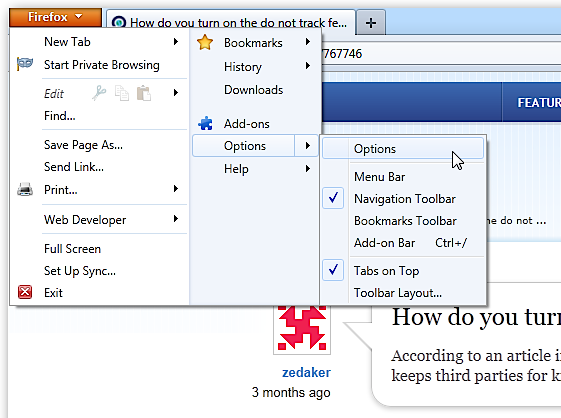Make Firefox 4 work for you

Firefox 4 is finally here, and while those familiar with how web browsers have evolved won't be surprised to see the streamlined new interface, it can come as a culture shock to those used to plodding along with Firefox 3 for the past few years. With that in mind, we've compiled 10 tips showcasing the best new features in Firefox 4.
Better still, we don't just explain what's new in Firefox 4, we'll reveal how the functionality works, so you can start using and benefiting from it too. Except where specifically stated, the tips should work on all platforms: Windows, Mac and Linux.
1. Navigate without the menu bar. Firefox 4 ditches the menu bar in Linux and Windows to free up screen space. While you can get it back again by right-clicking the toolbar and choosing Menu bar (Windows users can also press the left [Alt] key to bring it back temporarily), look out for the Firefox button in the top left-hand corner of the Firefox window: click here to get access to the most common options found on the menu bar.
2. Autocomplete from the "Awesome Bar." Firefox 4's location bar, nicknamed "Awesome Bar" by Mozilla, now has an autocomplete feature. As you type, suggestions from your history, bookmarks and other open tabs are presented, making it possible to quickly and easily jump to a site, even if you can't remember the exact URL.
3. Drop the tabs. By default, Firefox 4 displays tabs above the location bar. Choose right-click on the Tabs toolbar and remove the tick from Tabs on Top by clicking it to swap them around, just like it is in Firefox 3.6.
4. Pin app tabs. Create shortcuts to favorite websites (such as webmail) or even the Add-ons Manager itself by right-clicking the tab and choosing Pin as App Tab. A minimized tab will appear on the left of the tabs. Click it to access that website. Remove the tab by right-clicking it again and choosing Unpin Tab. Rearrange these tabs simply by dragging and dropping them into the desired order.
5. Preview tabs. Windows 7 users can take full advantage of the Aero Peek feature by clicking the Firefox button and choosing Options > Options > Tabs. Tick "Show tab previews in the Windows taskbar" and click OK to view thumbnails of all open tabs when you roll the mouse over the Firefox taskbar icon.
6. Organize your tabs. If you frequently have multiple tabs open at once you can find it difficult to organize them all. Firefox 4's new Panorama feature simplifies the process of tab management by allowing you to organize them into multiple groups.
First, right-click the toolbar and choose Customize, then drag and drop the Tab Groups icon on to the taskbar. Click the icon, and thumbnails of all your open tabs will be displayed together in a single group. Remove tabs from this group by dragging them away from the window, where they'll form their own group. Select a group and only the tabs in that group will be displayed, helping de-clutter your Firefox window.
7. Access your History. Want to quickly revisit a page from your history? Just right-click the page navigation buttons and a dropdown list of all recently visited pages on the current tab will appear. Just click the page you wish to visit.
8. Lose the trackers. While Firefox has supported private browsing sessions since version 3.5, Firefox 4 adds another feature: "Do not track." Certain websites place cookies on your computer, track your browsing activity and then sell that data on to advertisers. To opt out of this, open the Options dialog box, switch to the Advanced section and tick "Tell websites I do not wished to be tracked" in the General section before clicking OK.
9. Sharpen the text. You might notice that the fonts look a little blurry in Firefox 4 -- this is something that will no doubt be fixed in a future release, but for now you can improve the text's readability at the expense of performance on graphically intensive websites by clicking the Firefox button and selecting Options > Options. Switch to the Advanced tab, untick "Use hardware acceleration when available" and click OK.
10. Set up sync. Firefox Sync allows you to back up and sync your key settings -- passwords, bookmarks, history, tabs and preferences -- across all your computers and devices. Setting it up is not the quick and easy process it is for Chrome users. You'll need to create a Firefox Sync account on your first computer (click the Firefox button and choose "Set up Sync") -- this involves entering your email address, creating a strong password and either printing out or saving a Sync Key, which you may need later.
When you've set up the initial sync, click the Firefox button and choose Options > Options > Sync tab. Click "Add a Device." Here you're prompted to enter a code that you'll need to obtain from your second computer. To do this, launch Firefox on that computer, return to the same Sync tab (via File > Preferences on the Mac), then click "Set up Firefox Sync" followed by "Connect" to obtain the code. Entering this code on your primary computer will quickly bring both into sync with each other.
That's all well and good, but you can't always rely on your primary computer to be on when you want to set up sync on another device. This is where the Sync Key comes in. Just click the "I don't have the device with me" and then enter your email address, password and the Sync Key to set up the sync.
Get more great tips like this one at Software Crew.